Giant Electronics T5025 FRS User Manual
Giant Electronics Ltd FRS
User Manual
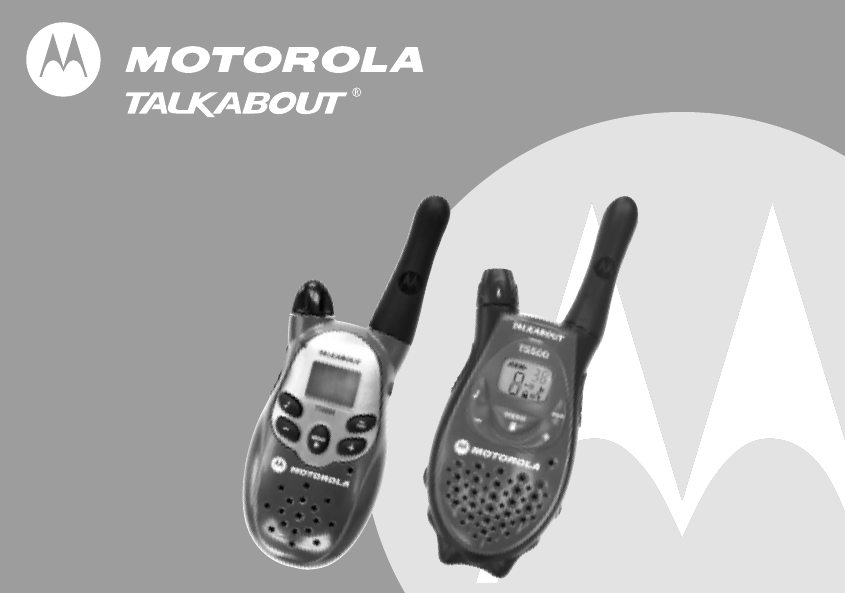
User's Guide
FRS/RECREATIONAL TWO-WAY RADIOS
KEM-PK10751-06 Models T5025 and T5525

Contents
Contents
Safety and General Information ...................... 2
Control Buttons..................................................11
Getting Started ..................................................12
Installing the the AA Batteries........................12
Installing the NiCd Battery Pack ....................12
Battery Meter....................................................13
Attaching the Belt Clip ....................................14
Removing the Belt Clip....................................14
Turning Your Radio On and Off......................14
Setting the Volume ..........................................14
Setting a Channel ............................................15
Talking and Listening ........................................16
Talk Range ........................................................16
Checking the Channel Before Transmitting ..16
Special Features ................................................17
Interference Eliminator Code..........................17
Push to Talk Timeout Timer ............................17
Locking the Keypad ........................................17
Scanning Channels..........................................18
Advanced Scan ................................................18
Alerts ..................................................................19
Channel Busy Indicator ..................................19
Setting and Transmitting Call Tones..............19
Transmitting a Talk Confirmation Tone..........20
QT Noise Filtering............................................20
Accessories ........................................................22
Using Audio Accessories ................................22
Voice Activation (VOX) ....................................22
Setting the Sensitivity Level ..........................23
Patent Information ............................................24
1

Safety and General Information
Safety and General Information
Important Information on Safe and Efficient Operation
Read This Information Before Using Your Radio.
The information provided in this document supersedes the general safety
information in user guides published prior to December 1, 2002.
Transmit and Receive Procedure
Your two-way radio contains a transmitter and a receiver. To control your
exposure and ensure compliance with the general population/uncontrolled
environment exposure limits, always adhere to the following procedure:
• Transmit no more than 50% of the time.
• To transmit (talk), press the Push to Talk (PTT) button.
• To receive calls, release the PTT button.
Transmitting 50% of the time, or less, is important because the radio generates
measurable RF energy exposure only when transmitting (in terms of measuring
standards compliance).
Exposure To Radio Frequency Energy
Your Motorola two-way radio complies with the following RF energy exposure
standards and guidelines:
• United States Federal Communications Commission, Code of Federal
Regulations; 47CFR part 2 sub-part J
2

Safety and General Information
• American National Standards Institute (ANSI) / Institute of Electrical and Electronic
Engineers (IEEE) C95. 1-1992
• Institute of Electrical and Electronic Engineers (IEEE) C95.1-1999 Edition
• International Commission on Non-Ionizing Radiation Protection (ICNIRP) 1998
• Ministry of Health (Canada) Safety Code 6. Limits of Human Exposure to
Radiofrequency Electromagnetic Fields in the Frequency Range from 3 kHz
to 300 GHz, 1999
• Australian Communications Authority Radiocommunications (Electromagnetic
Radiation --- Human Exposure) Standard, 2003
• ANATEL ANNEX to Resolution No. 303 of July 2, 2002 "Regulation of limitation of
exposure to electrical, magnetic and electromagnetic fields in the radio frequency
range between 9 KHz and 300 GHz" and "Attachment to resolution # 303 from
July 2, 2002"
To assure optimal radio performance and make sure human exposure to radio
frequency electromagnetic energy is within the guidelines set forth in the above
standards, always adhere to the following procedures.
Portable Radio Operation and EME Exposure
Antenna Care
Use only the supplied or an approved replacement antenna. Unauthorized
antennas,modifications, or attachments could damage the radio and may violate
FCC regulations.
DO NOT hold the antenna when the radio is “IN USE.” Holding the antenna affects
the effective range. 3

Safety and General Information
Two-way Radio Operation
When using your radio as a traditional two-way radio, hold the radio in
a vertical position with the microphone 1 to 2 inches (2.5 to 5 cm)
away from the lips.
Body-Worn Operation
To maintain compliance with FCC/Health Canada RF exposure guidelines, if you
wear a radio on your body when transmitting, always place the radio in a Motorola-
supplied or approved clip, holder, holster, case, or body harness for this product.
Use of non-Motorola-approved accessories may exceed FCC/Health Canada RF
exposure guidelines.
If you do not use one of the Motorola-supplied or approved body-worn accessories,
and are not using the radio held in the normal use position, ensure the radio and its
antenna are at least 1 inch (2.5 cm) from your body when transmitting.
Data Operation
If applicable, when using any data feature of the radio with or without an accessory
cable, position the radio and its antenna at least 1 inch (2.5 cm) from the body.
Approved Accessories
For a list of approved Motorola accessories, visit our website at www.Motorola.com.
Electromagnetic Interference/Compatibility
Note: Nearly every electronic device is susceptible to electromagnetic interference
(EMI) if inadequately shielded, designed, or otherwise configured for electro-
magnetic compatibility.
4

Safety and General Information
Facilities
To avoid electromagnetic interference and/or compatibility conflicts, turn off your
radio in any facility where posted notices instruct you to do so. Hospitals or health
care facilities may be using equipment that is sensitive to external RF energy.
Aircraft
When instructed to do so, turn off your radio when on board an aircraft. Any use
of a radio must be in accordance with applicable regulations per airline crew
instructions.
Medical Devices - Pacemakers
The Advanced Medical Technology Association recommends that a minimum
separation of 6 inches (15 cm) be maintained between a handheld wireless radio
and a pacemaker. These recommendations are consistent with the independent
research by, and recommendations of the U.S. Food and Drug Administration.
Persons with pacemakers should:
• ALWAYS keep the radio more than 6 inches (15 cm) from their pacemaker when
the radio is turned ON.
• Not carry the radio in the breast pocket.
• Use the ear opposite the pacemaker to minimize the potential for interference.
• Turn the radio OFF immediately if you have any reason to suspect that
interference is taking place.
5

Safety and General Information
Medical Devices - Hearing Aids
Some digital wireless radios may interfere with some hearing aids. In the event
of such interference, you may want to consult your hearing aid manufacturer to
discuss alternatives.
Other Medical Devices
If you use any other personal medical device, consult the manufacturer of your
device to determine if it is adequately shielded from RF energy. Your physician
may be able to assist you in obtaining this information.
Safety and General Use While Driving
Check the laws and regulations on the use of radios in the area where you drive.
Always obey them. When using your radio while driving, please:
• Give full attention to driving and to the road.
• Use hands-free operation, if available.
• Pull off the road and park before making or answering a call if driving
conditions so require.
Operational Warnings
For Vehicles with an Air Bag
Do not place a portable radio in the area over an air bag or in the air bag deploy-
ment area. Air bags inflate with great force. If a portable radio is placed in the air
bag deployment area and the air bag inflates, the radio may be propelled with
great force and cause serious injury to occupants of the vehicle.
6

Safety and General Information
Potentially Explosive Atmospheres
Turn off your radio prior to entering any area with a potentially explosive
atmosphere, unless it is a radio type especially qualified for use in such areas as
“Intrinsically Safe.”
Do not remove, install, or charge batteries in such areas. Sparks in a potentially
explosive atmosphere can cause an explosion or fire resulting in bodily injury or
even death.
Note: The areas with potentially explosive atmospheres referred to above include
fueling areas such as below decks on boats, fuel or chemical transfer or
storage facilities, areas where the air contains chemicals or particles, such
as grain, dust, or metal powders, and any other area where you would nor-
mally be advised to turn off your vehicle engine. Areas with potentially
explosive atmospheres are often but not always posted.
Blasting Caps and Areas
To avoid possible interference with blasting operations, turn off your radio when
you are near electrical blasting caps, in a blasting area, or in areas posted: “Turn
off two-way radio.” Obey all signs and instructions.
Operational Cautions
Antennas
Do not use any portable radio that has a damaged antenna. If a damaged antenna
comes into contact with your skin, a minor burn can result. 7

Safety and General Information
Batteries
All batteries can cause property damage and/or bodily injury such as burns if a
conductive material such as jewelry, keys, or beaded chains touch exposed termi-
nals. The conductive material may complete an electrical circuit (short circuit) and
become quite hot. Exercise care in handling any charged battery, particularly
when placing it inside a pocket, purse, or other container with metal objects.
Battery Charger Safety Instructions
Save these Instructions
1. Do not expose the charger to rain or snow.
2. Do not operate or disassemble the charger if it has received a sharp blow, or
has been dropped or damaged in any way.
3. Never alter the AC cord or plug provided with the unit. If the plug will not fit
the outlet, have the proper outlet installed by a qualified electrician. An
improper condition can result in a risk of electric shock.
4. To reduce the risk of damage to the cord or plug, pull the plug rather than the
cord when disconnecting the charger from the AC receptacle.
5. To reduce the risk of electric shock, unplug the charger from the outlet before
attempting any maintenance or cleaning.
6. Use of an attachment not recommended or sold by Motorola may result in a
risk of fire, electric shock, or personal injury.
8

Safety and General Information
7. Make sure the cord is located so it will not be stepped on, tripped over, or
subjected to damage or stress.
8. An extension cord should not be used unless absolutely necessary. Use of an
improper extension cord could result in a risk of fire and/or electric shock. If an
extension cord must be used, make sure that:
• The pins on the plug of the extension cord are the same number, size and
shape as those on the plug of the charger.
• The extension cord is properly wired and in good electrical condition.
• The cord size is 18 AWG for lengths up to 100 feet, and 16 AWG for lengths up
to 150 feet.
9. The supply cord of this charger cannot be replaced. If the cord is damaged, call
Motorola Product Services at 1-800-353-2729 in USA or 1-888-390-6456 TTY
(Text Telephone).
9
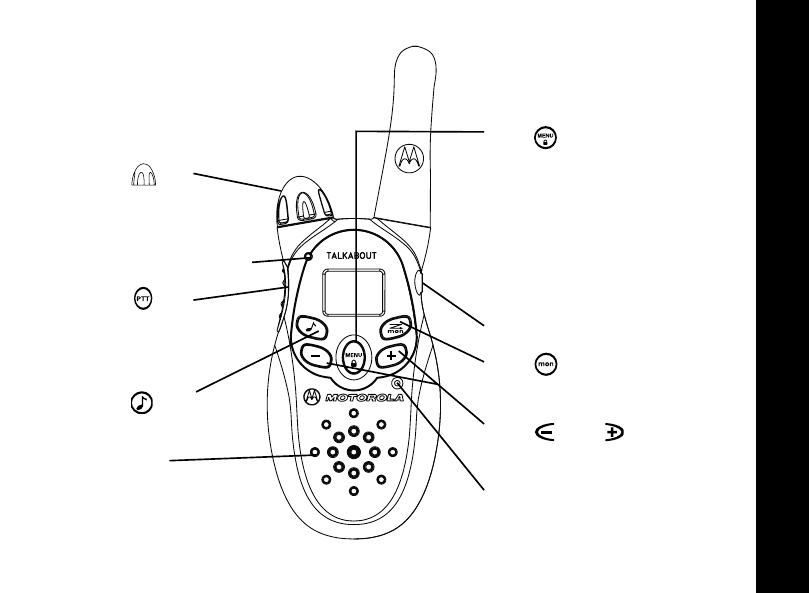
T5025
Control Buttons - Model T5025
Control Buttons - Model T5025
10
Use to:
• Select menu options
• Exit the menu (when
pressed while in a
menu)
• Lock and unlock the
keypad (when held
down and not in
menu)
Accessory Jack
Use to:
• Scan
Use and to:
• Scroll through menus
Microphone
Use to:
• Turn radio on/off
• Adjust volume
LED indicator light
Use to:
• Talk
• Save a setting
Use to:
• Transmit call tone
Speaker
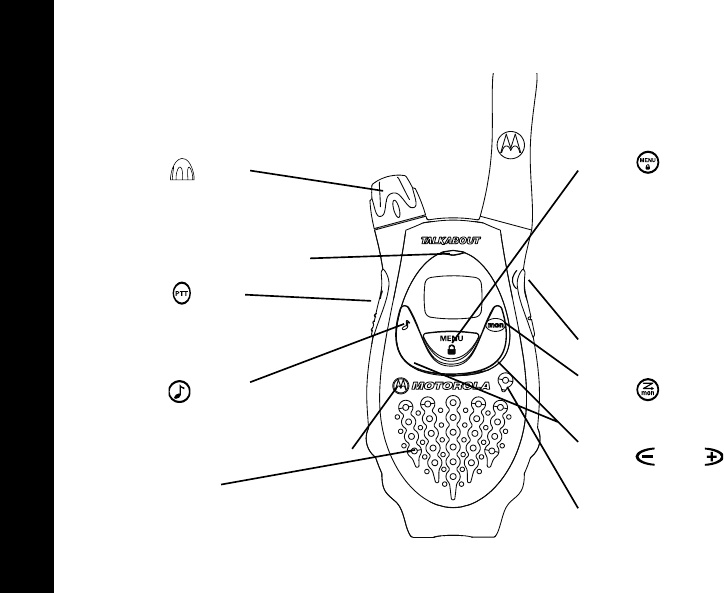
T5525
Control Buttons - Model T5525
Control Buttons - Model T5525
11
Use to:
• Select menu options
• Exit the menu (when
pressed while in a
menu)
• Lock and unlock the
keypad (when held
down and not in a
menu)
Accessory Jack
Use to:
• Scan
Use and to:
• Scroll through menus
Microphone
Use to:
• Turn radio on/off
• Adjust volume
LED indicator light
Use to:
• Talk
• Save a setting
Use to:
• Transmit call tone
Removeable front cover
Speaker
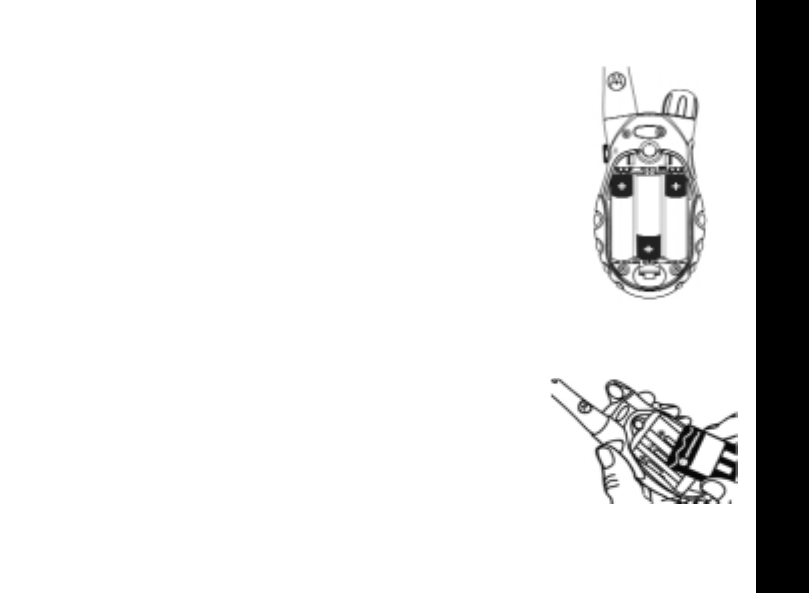
Getting Started
Getting Started
Installing the AA Batteries
Your radio uses 3 AA Alkaline batteries.
1. With the back of the radio facing you, lift the battery latch
up to release the battery cover and remove the cover.
2. Insert 3 AA Alkaline batteries as shown on the inside of the
battery compartment.
3. Reposition the battery cover and press down to secure.
Note: The T5025 and T5525 model radios can use a NiCd
rechargeable battery instead of 3 AA Alkaline batteries.
A rechargeable battery upgrade kit, is available for
these radios.
Installing the NiCd Battery Pack
1. Follow step 1 above to remove the battery cover.
2. Remove the battery pack from the clear plastic bag.
Do not disassemble or unwrap the battery pack.
3. Insert the NiCd battery pack so the matel contacts on the
side of the battery are facing outward from the radio to
connect with the contacts on the battery door.
4. Reposition the battery cover and press down to secure. 12

Getting Started
Battery Meter
The battery icon shows the battery charge level, from full to empty . When
the battery is empty, the radio chirps periodically after releasing . The radio powers
off when the voltage drops below a predetermined level to protect the rechargeable
battery.
Note: Remove the batteries before storing your radio for extended periods of time.
Batteries corrode over time and may cause permanent damage to your radio.
Using the Desk Stand Charger (Optional Accessory)
The desk stand charger provides drop-in charging convenience for NiCd batteries and
can be placed on any flat surface, such as a desk or workbench. Charge the NiCd bat-
tery overnight (at least 16 hours) before using it for the first time. After the initial
charge, an empty battery is fully charged within 14 hours.
1. Turn the radio off and remove the battery cover.
2. Remove the battery pack from the clear plastic bag. Do not disassemble or unwrap
the battery pack.
3. Insert the NiCd battery pack so the metal contacts on the side of the battery are fac-
ing outward from the radio to connect with the contacts on the battery door.
4. Reposition the battery cover and press down to secure.
5. Plug the AC power supply into the plug on the desk stand.
6. Plug the AC power supply into a standard wall outlet.
7. Remove the battery pocket inserts from the charger pockets.
8. With a radio facing forward, slide it into one of the charging pockets.
13
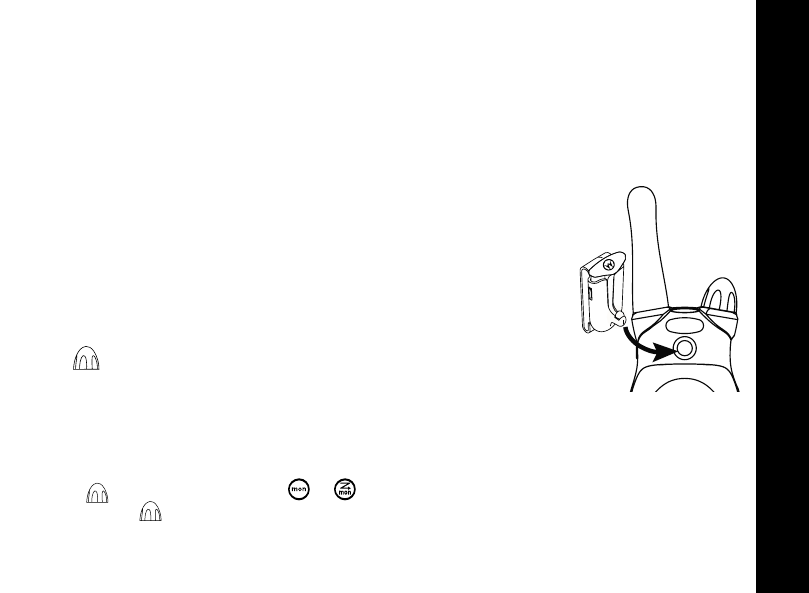
Getting Started
Notes
• The light on the charging base will glow continuously when radio/battery is inserted.
• When moving between hot and cold temperatures, do not charge the battery until
the battery temperature acclimates (usually about 20 minutes).
• For optimal battery life, remove the radio or battery from the charger within
16 hours. Do not store the radio in the charger.
Attaching the Belt Clip
1. Align the belt clip post with the hole in the back of the radio.
2. Gently push until the clip clicks into place.
Removing the Belt Clip
1. Push down on the release tab at the top of the belt clip to
release the catch.
2. Pull the belt clip away from the back of the radio.
Turning Your Radio On and Off
Turn clockwise to turn the radio on and counterclockwise to
turn the radio off.
The radio chirps and the display briefly shows all feature icons
available on your radio. The display then scrolls through the available channels and
Interference Eliminator Codes.
Setting the Volume
Rotate while holding down or until you reach a comfortable listening
level. Rotate clockwise to increase the volume or counterclockwise to decrease
the volume. 14

Getting Started
Setting a Channel
Your radio has 14 channels.
1. With the radio on, press . The current channel flashes.
2. Press or to set the channel.
3. Press to save the channel setting.
15

Talking and Listening
Talking and Listening
To communicate, all radios in your group must be set to the same channel and
Interference Eliminator Code.
To talk, press and hold . Hold the radio 2 to 3 inches away from your mouth
when talking.
When you finish talking, release (press to talk, release to listen).
Talk Range
Your radio is designed to maximize performance and improve transmission range.
Do not use the radios closer than 5 feet apart.
Checking the Channel Before Transmitting
Your radio has multiple channels shared on a "take turns" basis. For uninterrupted
communication, do not talk on a channel is someone else is currently talking on it.
To check for activity on a channel before you talk, press and hold or . If you
hear static, the channel is clear to use.
16
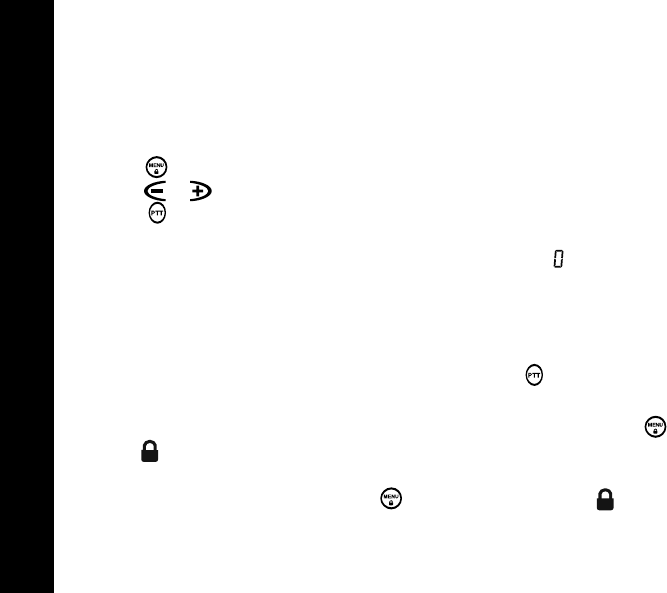
Special Features
Special Features
Interference Eliminator Code
Interference Eliminator Codes help minimize interference by providing you with a
choice of code combinations.
To set the code for a channel:
1. Press until the code starts to flash.
2. Press or to select the code.
3. Press to save the code setting.
You can set a different code for each channel using this procedure.
Note: You must set the Interference Eliminator Code to on an FRS radio that uses
Interference Eliminator Codes to communicate with other FRS radios that do
not have Interference Eliminator Codes.
Push to Talk Timeout Timer
To prevent accidental transmissions and save battery life, the radio emits a continu-
ous warning tone and stops transmitting if you press for 60 continuous seconds.
Locking the Keypad
To avoid accidentally changing your radio settings, press and hold for 3 seconds
or until displays. You can turn the radio on and off, adjust the volume, receive,
transmit, send a call tone, and monitor channels. All other functions are locked.
To unlock the radio, press and hold for 3 seconds or until is no longer
displayed.
17
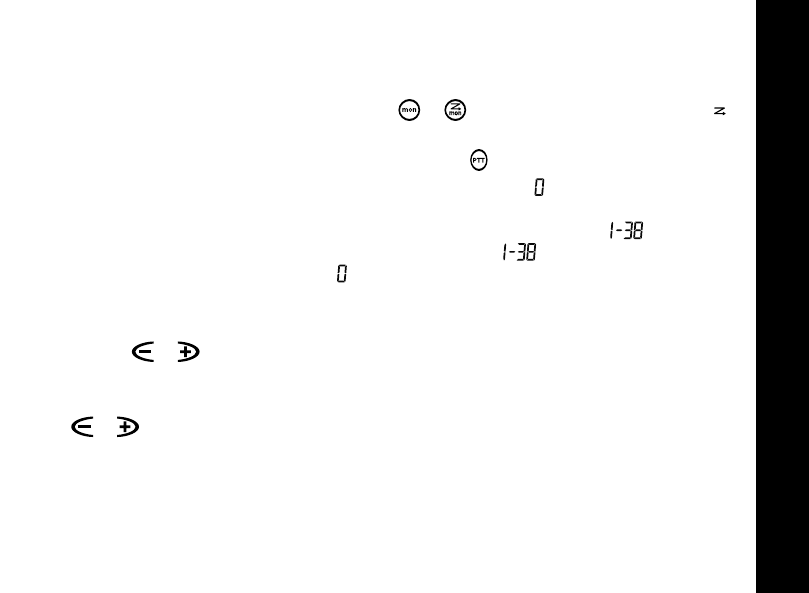
Special Features
18
Scanning Channels
Use scanning to monitor channels and codes for transmissions or to find someone
in your group who has accidentally changed channels.
To start scanning, briefly press and release or . The scan indicator displays .
When the radio detects channel activity, it stops scanning and you can hear the
transmission. To respond to the transmitting, press within 5 seconds.
Note: If your radio's Interference Eliminator Code is set to while scanning, the
radio checks for activity on each channel regardless of the code used on the
channel. If your radio's Interference Eliminator Code is set to , the radio
checks for activity only on channels using codes and
ignores channels using code .
Advanced Scan
If the radio stops scanning on a channel you do not want to listen to, briefly press
and release or to resume scanning for the next active channel.
Removing Channels from the Scan List (Nuisance Delete Feature)
To remove a channel so the radio does not stop on it while scanning, press and
hold or for at least 3 seconds, then release. This temporarily removes the
channel from the scan list.
To restore the channel, turn the radio off and then back on.
Note: You cannot remove the channel your radio was set to when you started the
scan (called your home channel).
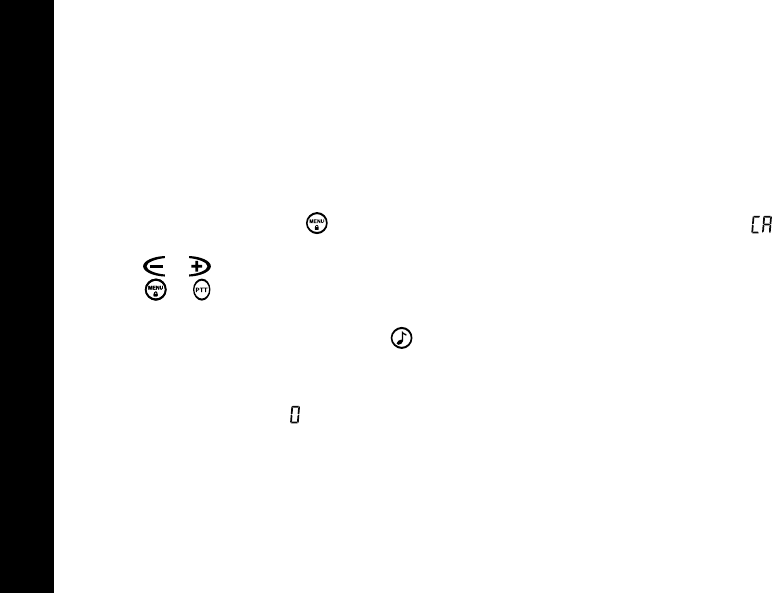
Alerts
Alerts
Channel Busy Indicator
When a channel is busy, the LED flashes twice per second.
Setting and Transmitting Call Tones
Your radio can transmit different call tones to other radios in your group so you
can alert them that you want to talk.
To set a call tone:
1. With the radio on, press 3 times. The current call tone setting flashes and
displays.
2. Press or to change and hear the call tone.
3. Press or to set the new call tone.
To transmit your call tone to other radios set to the same channel and Interference
Eliminator Code as your radio, press .
Notes
• The T5025 model has 5 call tones. The T5525 model has 10 call tones.
• Setting the call tone to disables the call tone feature.
19
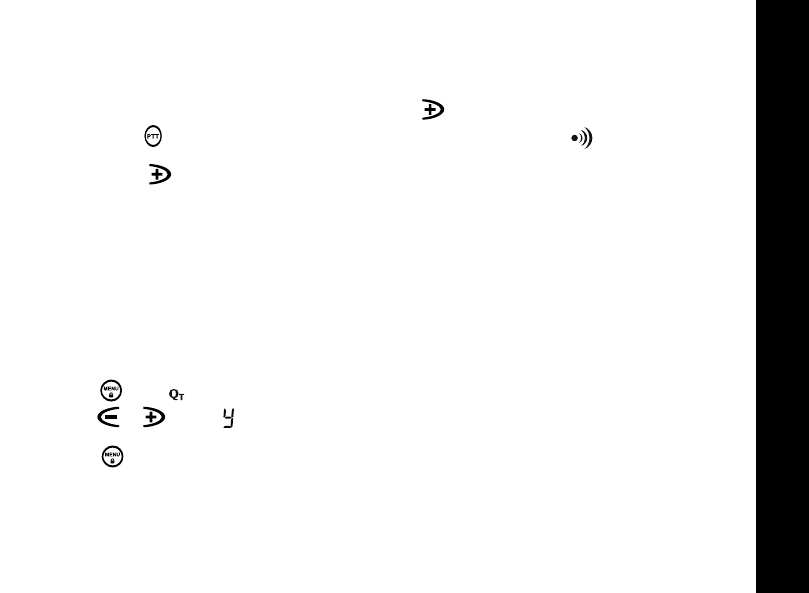
Alerts
Transmitting a Talk Confirmation Tone
You can set your radio to transmit an unique tone when you finish transmitting.
It's like saying Roger or Over to let others know you are finished talking.
• To turn talk confirmation on, press and hold while you turn the radio on. When
you release after transmitting, your call tone transmits and displays.
• To turn talk confirmation off, turn your radio off and then back on while pressing
and holding .
QT Noise Filtering
The QT noise filtering feature helps ensure uninterrupted communication with
other Motorola radios that have this feature. This feature filters out unwanted
transmissions from other radios. It is useful in places where there is heavy radio
traffic, such as at an amusement park or ski resort.
Note: QT noise filtering is not available while the radio is scanning.
To turn QT noise filtering on or off:
1. Press until displays.
2. Press or until displays to turn noise filtering on, or until – displays to
turn noise filtering off.
3. Press to confirm your selection.
20

Alerts
To transmit to a radio that has QT noise filtering turned on:
1. Select the same channel and Interference Eliminator Code as the other radio.
2. Press to send a call tone. This allows your voice to pass through the QT
noisefilter on the receiving radio.
3. Press and speak normally.
Note: If you skip step 2, the beginning of your message may not be heard on the
receiving radio.
For a 30-second period, starting after the last transmission, all transmis-
sions received on the selected channel and code will pass through the QT
noise filter.
21

Accessories
Accessories
There are many accessories (sold separately) available for your radio. For more
information, refer to the brochure included with your radio, contact the place of
purchase.
Using Audio Accessories
1. Turn the radio off. Plug the accessory connector into the jack. See page 11 and
12 for the location of the accessory jack on your radio.
2. Turn the radio on. Lower the volume before placing the accessory on your head
or in your ear.
3. Press or while rotating to adjust the volume to a comfortable level.
4. To transmit, press and speak into the accessory microphone, if any.
5. To receive, release .
Voice Activation (VOX) (T5525)
Voice activation (VOX) allow you to talk handsfree when used with optional acces-
sories connected to the radio. See the Motorola Talkabout accessory brochure for
available VOX accessories.
1. Turn the radio off.
2. Insert the plug of the audio accessory firmly into the accessory jack.
3. Turn the radio on. displays.
4. Lower the radio volume before placing the accessory on your head or in your ear.
22

Accessories
5. To transmit, speak into accessory microphone. There is a short delay between
the time you start talking and when the radio transmits.
6. To receive, stop talking.
To turn VOX off, press or remove the audio accessory.
Setting the Sensitivity Level
Adjusting the radio’s sensitivity level helps minimize the possibility of unintended
noises triggering a transmission and helps the radio pick up soft voices.
1. Press until displays.
2. Press or to select the sensitivity level:
Note: When you connect a VOX accessory, the radio is automatically set to the
last chosen sensitivity level.
23
= High Sensitivity
for quiet environments = Medium Sensitivity
for most environments = Low Sensitivity
for noisy environments

Patent Information
Patent Information
This product is manufactured under one or more of the following United States
patents.
5896277 5894292 5864752 5699006 5742484 D408396 D399821 D387758 D389158
5894592 5893027 5789098 5734975 5861850 D395882 D383745 D389827 D389139
5929825 5926514 5953640 6071640 D413022 D416252 D416893 D433001
24
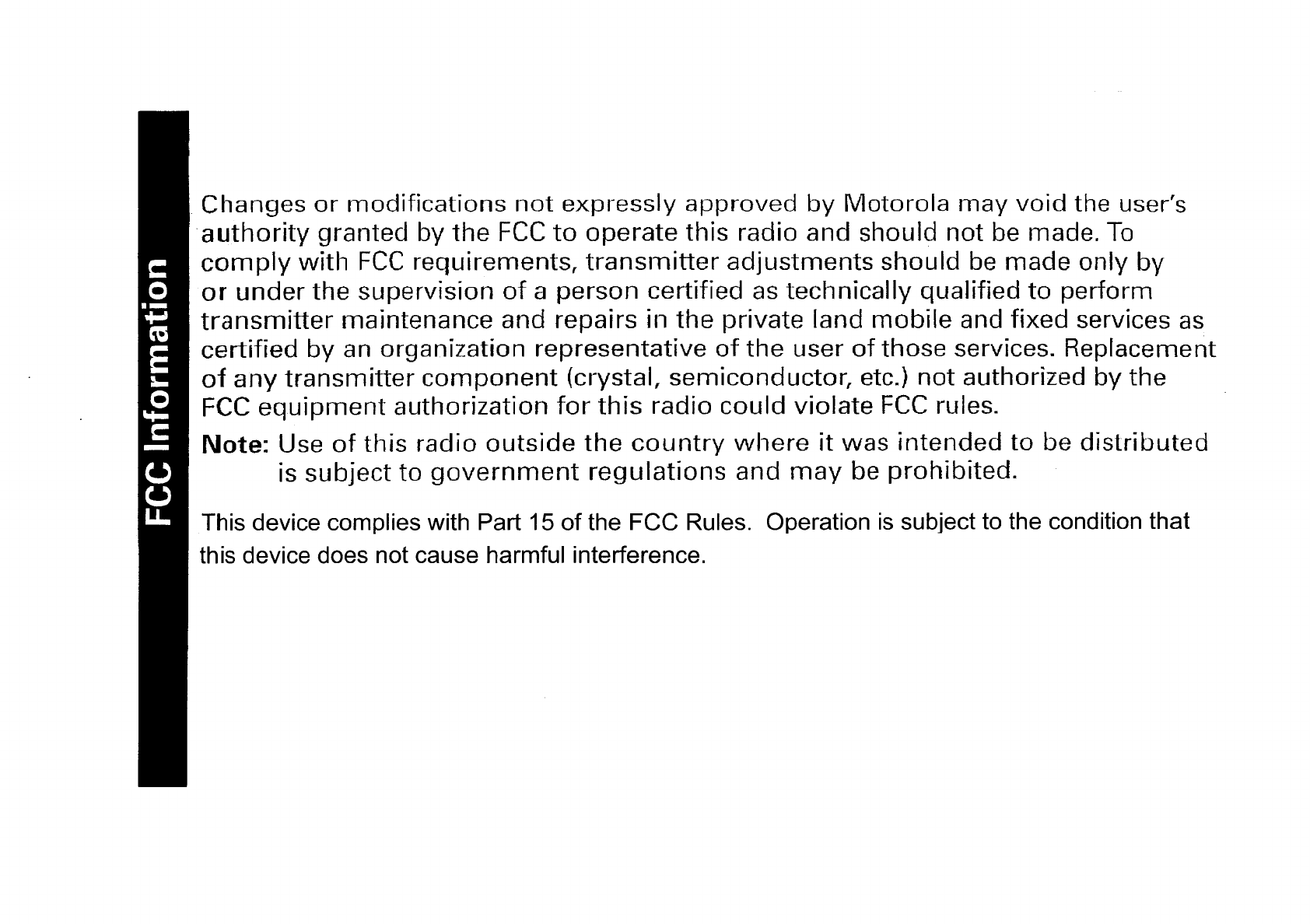
Operation is subject to the following two
conditions: (1) this device may not cause harmful interference, and (2) this device must accept any interfence
received, including interference that may cause undesired operation.

Motorola, the Stylized M Logo, and other Motorola trademarks and trade dress are owned by Motorola, Inc. and are used
under license from Motorola, Inc. MOTOROLA and the Stylized M Logo are registered in the U.S. Patent & Trademark Office.
All other products or service names are the property of their respective owners. © Motorola, Inc. 2004.
WARNING CHOKING HAZARD
SMALL PARTS
Not for children under 3 years.
This product is not intended to be used
as a toy or plaything.
• 14 Channels with
38 Interference
Eliminator Codes
FRS channels feature
increased power for longer
range. 14 channels ensure
backward compatibility with
FRS two-way radios.
Eliminator Codes minimize
interference from other
groups.
• Scanning
Easily finds channel and
code by searching all
combinations.
• QT Noise Filter
Filters out unwanted
transmissions in heavy
radio traffic areas.
• Audible Call Tones
5 call tones (Model T5025)
10 call tones (Model T5525).
• Talk Handsfree
(T5525 only)
With Voice Activation (VOX)
when used with optional
accessories.
• Motorola Quality
Shock, drop, and temperature
tested to meet Motorola's
high quality standards.
• Talk Confirmation Tones
Signals others you are
finished talking.
• Durable, Fixed Antenna
Maximizes talk range.
• Weather-resistant
Helps protect radios against
the elements.
• 1 Year Limited Warranty
For warranty details, please
ask your retailer.
• Low Battery Alert
Audible tone and visual
display tell you when the
battery is running down.
• Illuminated Display
Easy to read your settings in
dark places.
• Quick Release Swivel
Belt Clip Included
• User's Guide Included